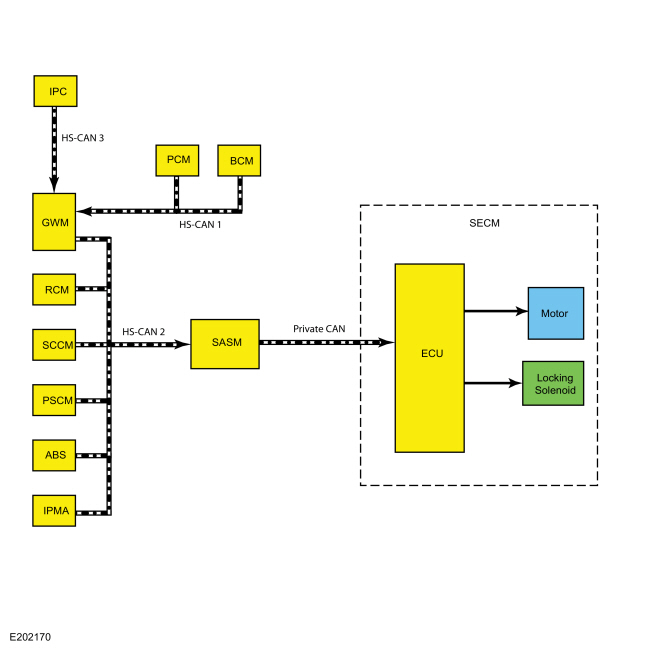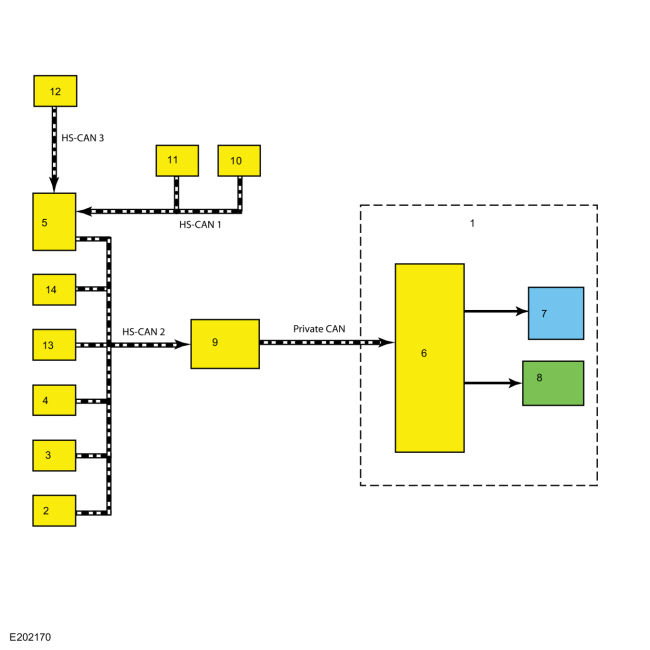Lincoln Nautilus: Power Steering / Adaptive Steering - System Operation and Component Description. Description and Operation
System Operation
System Diagram

| Item | Description |
|---|---|
| 1 | SECM |
| 2 | IPMA |
| 3 | ABS module |
| 4 | PSCM |
| 5 | GWM |
| 6 | ECU |
| 7 | Adaptive steering motor |
| 8 | Adaptive steering locking solenoid |
| 9 | SASM |
| 10 | BCM |
| 11 | PCM |
| 12 | IPC |
| 13 | SCCM |
| 14 | RCM |
Network Input Message Chart
SECM Network Input Messages
| Broadcast Message | Originating Module | Message Purpose |
|---|---|---|
| ABS active | ABS module | Used to inform the SECM an ABS event is taking place. |
| Active front steering request | ABS module | Used to request steering angle changes for stability control events. |
| EPAS fail | PSCM | Used to inform the SECM of an EPAS or PSCM failure. |
| Lane keeping system status | IPMA | Informs the SECM of the current lane keeping system status. |
| Odometer master value | IPC | This message is sent to the GWM and then to the SECM . Provides the SECM with the current odometer value in kilometers. |
| Power pack status | PCM | This message is sent to the GWM and then to the SECM . Used to inform the SECM of powertrain status; OFF-torque not available, ON-torque not available, Start in Progress-torque not available, ON-torque available. |
| Restraint impact event status | RCM | Informs the SECM of airbag deployment and fuel system cutoff due to a vehicle impact event. |
| Stability control event in progress | ABS module | Used to inform the SECM a stability control event is taking place. |
| Steering wheel angle | ABS module | Provides the SECM with steering wheel angle information for clear vision compensation. |
| Steering wheel heat request | IPC | This message is sent to the GWM and then to the SECM . Informs the SECM the driver has requested the heated steering wheel to be activated. |
| Transport mode | BCM | This message is sent to the GWM and then to the SECM . Used to confirm the vehicle is in normal operation mode, factory mode or transport mode. |
| Turn signal status | SCCM | Informs the SECM of the current turn signal status; LEFT, RIGHT or OFF. |
| Vehicle braking command | ABS module | Used to inform the SECM of vehicle braking. |
| Vehicle configuration information | BCM | This message is sent to the GWM and then to the SECM . Provides the SECM with the current vehicle configuration (central car configuration). |
| Vehicle speed | PCM | This message is sent to the GWM and then to the SECM . Used to inform the SECM of the current vehicle speed. |
| Vehicle yaw data | ABS module | Provides the SECM with vehicle yaw data for clear vision compensation. |
Adaptive Steering System
The SECM controls the functions of the adaptive steering system and communicates with other modules through the SASM over the HS-CAN2 . The SECM and the SASM communicate over a private CAN .
To activate, the SECM requires battery voltage, ignition voltage and must communicate with other modules over the HS-CAN2 . The SECM must also receive the power pack status message from the PCM in order to activate.
The SECM uses a motor to turn a toothed hub connected to the steering shaft to add or subtract incremental turns to the driver steering shaft input. At low speeds the same steering input from the driver delivers more front wheel angle, providing more low-speed agility. Low speed maneuvers require significantly less steering wheel rotation. At high speeds, straight line driving precision is increased, providing the driver with an improved highway driving experience and feel during moderate-to-high-speed cornering.
As the driver turns the steering wheel, the SASM detects the speed and direction of the steering wheel rotation and transmits this information to the SECM over a private CAN . The SECM responds by activating the motor in the appropriate direction and speed to assist in turning the front wheels and reducing the necessary number of steering wheel turns required by the driver.
The SECM is self-monitoring and is capable of setting and storing Diagnostic Trouble Codes (DTCs). Depending on the nature of the DTC set, the SECM may send a request to the IPC to illuminate the adaptive steering system warning indicator and display a message in the message center, alerting the driver of a potential adaptive steering system concern. The warning message is sent over the HS-CAN2 to the GWM where it is converted to a HS-CAN3 message and forwarded on to the IPC over the HS-CAN3 .
Adaptive Steering Lock
The adaptive steering system is designed with a locking device. While the lock is engaged, the steering system is set to a fixed (1:1) steering ratio. A sound may be heard when the vehicle is started or shut off as the lock is disengaged or engaged and a slight movement of the steering wheel may be noticed while the locking action is taking place. If the vehicle loses electrical power or the SECM detects a fault while driving, the lock is engaged. Extreme operating conditions may also cause the SECM to engage the lock. This strategy prevents overheating and permanent damage to the adaptive steering system. Typical steering and driving maneuvers allow the system to cool and return to normal operation. While the lock is engaged, it is possible the steering wheel may not be straight when the vehicle is driving straight ahead and the driver may notice the steering wheel angle or "clear vision" may be off-set.
The locking solenoid also engages when the ignition is set to ON and the driver door is closed, this prevents the steering wheel from turning unnecessarily while the system is off and affecting steering wheel clear vision. The locking solenoid disengages once the engine is started.
Heated Steering Wheel
The SECM is also the controlling ECU for the heated steering wheel
system. For additional information on heated steering wheel
functionality,
Refer to: Steering Wheel and Column Electrical Components (211-05 Steering Wheel and Column Electrical Components)
.
Component Description
Adaptive Steering Locking Solenoid
The locking solenoid is a normally engaged (locked) solenoid which requires a voltage input to disengage (unlock). This provides a fail-safe in case of SECM or adaptive steering system failure.
Adaptive Steering Motor
The adaptive steering motor is a reversible, variable speed motor with an attached worm gear. The motor is internal to the steering wheel and is serviced with the steering wheel.
SECM
The SECM is the ECU for the adaptive steering system. The module monitors all sensor inputs and HS-CAN2 messages relating to the adaptive steering system and directly controls the output of the adaptive steering motor. The SECM is internal to the steering wheel and is serviced with the steering wheel.
 Power Steering - Overview. Description and Operation
Power Steering - Overview. Description and Operation
Overview
The EPAS
system provides steering assist by replacing the conventional
hydraulic valve system with a steering gear equipped with an integrated
electrical motor and PSCM ...
 Power Steering - System Operation and Component Description. Description and Operation
Power Steering - System Operation and Component Description. Description and Operation
System Operation
System Diagram
Item
Description
1
EPAS gear
2
EPAS gear motor
3
EPAS gear motor position sensor
4
EPAS gear motor torque sensor
5
PSCM
6
ABS module
7
BCM
8
PAM
9
PCM
Network Message Chart
Module Network Input Messages: Power Steering Control Module (PSCM..
Other information:
Lincoln Nautilus 2018-2025 Service Manual: Battery Monitoring Sensor. Removal and Installation
Removal NOTE: When the battery is disconnected and connected, some abnormal drive symptoms may occur while the vehicle relearns its adaptive strategy. The vehicle may need to be driven to allow the PCM to relearn the adaptive strategy values. NOTE: The cowl panel is removed for clarity only. NOTE: Removal steps in this procedure may contain installation details. NOTICE: ..
Lincoln Nautilus 2018-2025 Service Manual: Exterior Front Door Handle. Removal and Installation
Removal NOTE: LH side shown, RH side similar. Both doors Remove the front door trim panel. Refer to: Front Door Trim Panel (501-05 Interior Trim and Ornamentation, Removal and Installation). NOTE: The front door removed for clarity. Remove the front door watershield. Remove the grommet. Release the..
Categories
- Manuals Home
- 1st Generation Nautilus Owners Manual
- 1st Generation Nautilus Service Manual
- Power Outlet - Vehicles With: 110V Power Outlet
- USB Ports
- Auto Hold
- New on site
- Most important about car
Auto-Start-Stop
What Is Auto-Start-Stop
The system is designed to help reduce fuel consumption and CO2 emissions by stopping the engine when it is idling, for example at traffic lights.
Auto-Start-Stop Precautions
WARNING: Apply the parking brake, shift into park (P), switch the ignition off and remove the key before you leave your vehicle. Failure to follow this instruction could result in personal injury or death.
WARNING: Apply the parking brake, shift into park (P), switch the ignition off and remove the key before you open the hood or have any service or repair work completed. If you do not switch the ignition off, the engine could restart at any time. Failure to follow this instruction could result in personal injury or d

